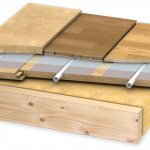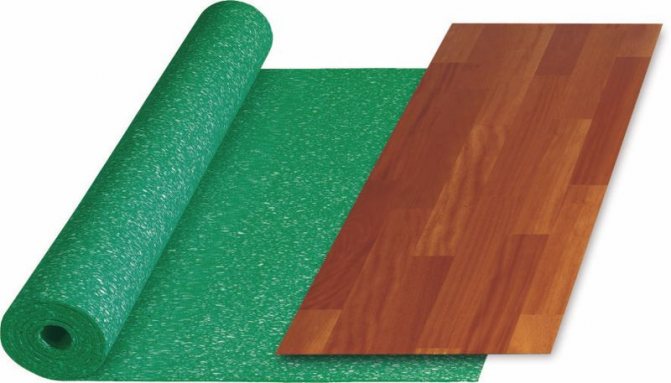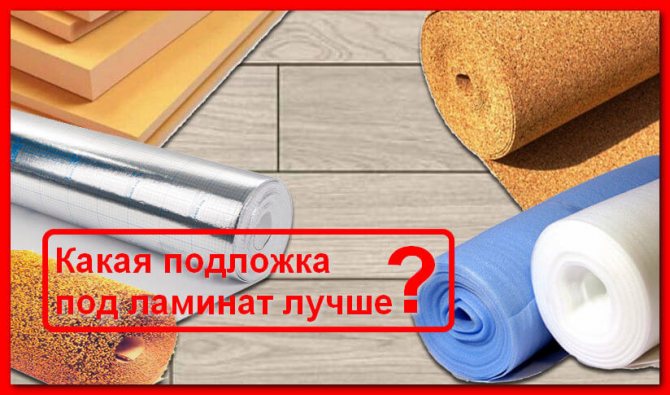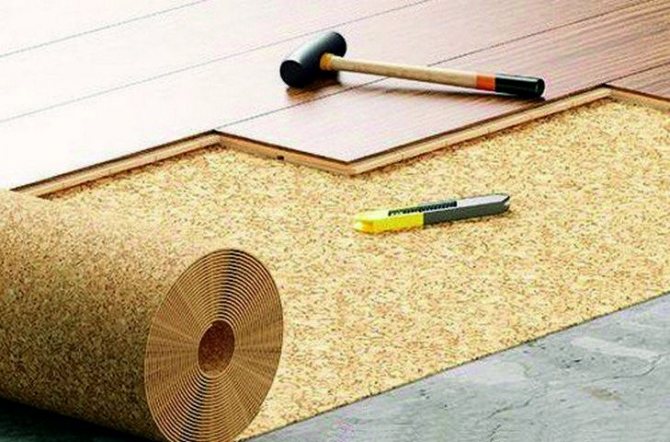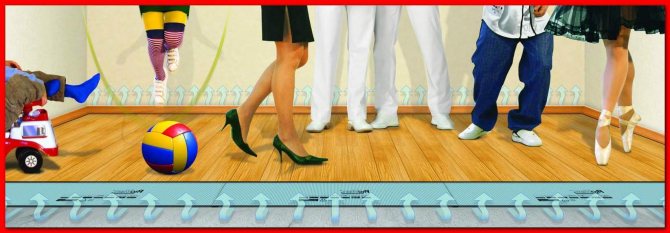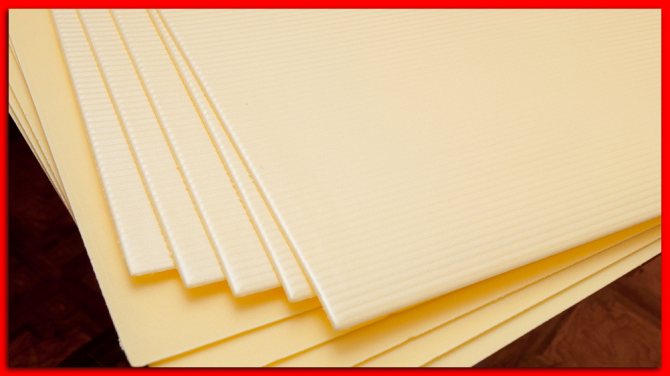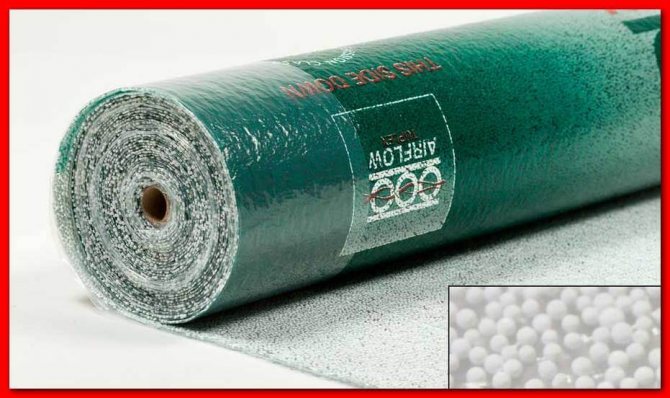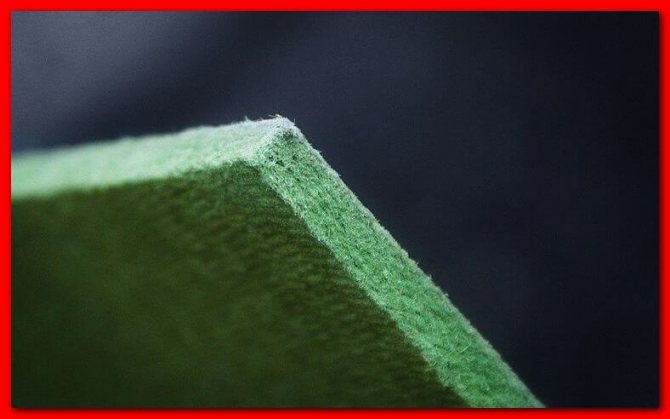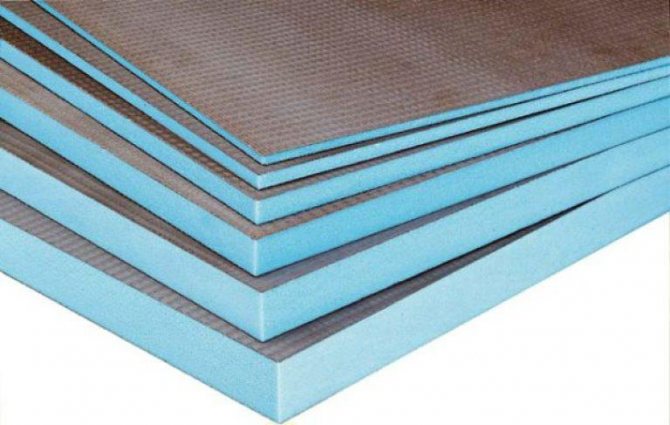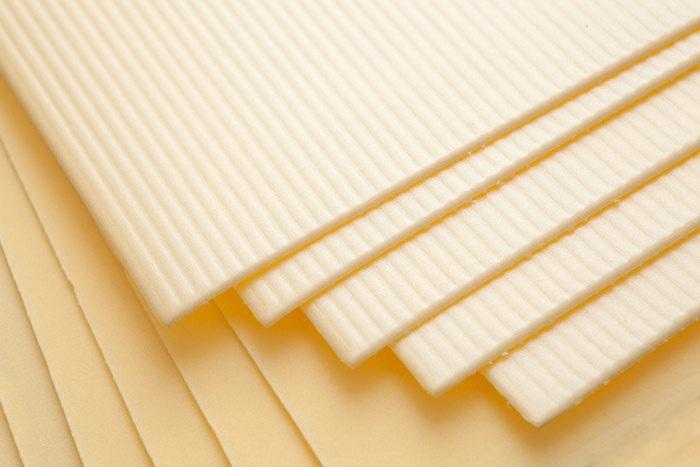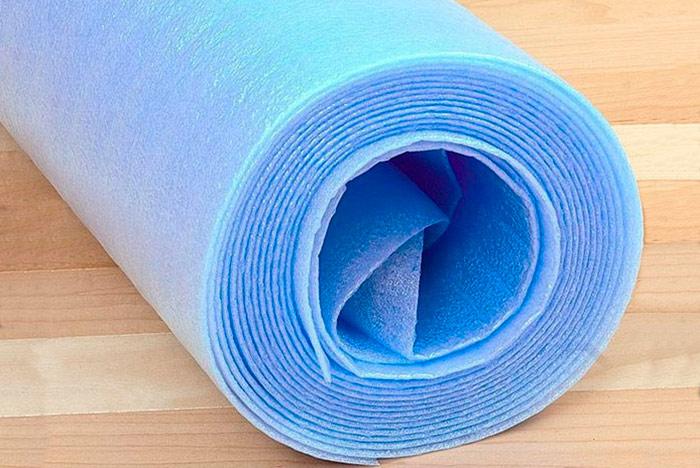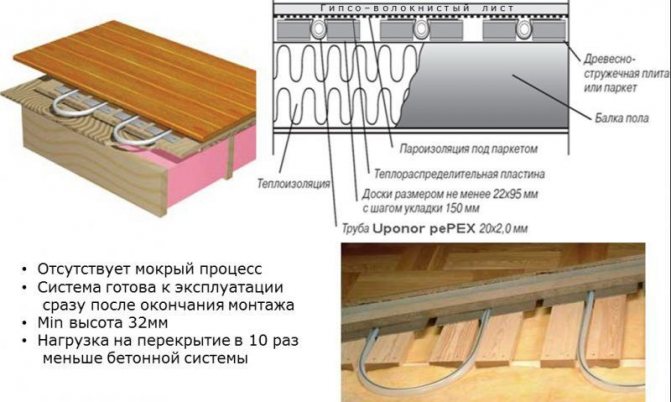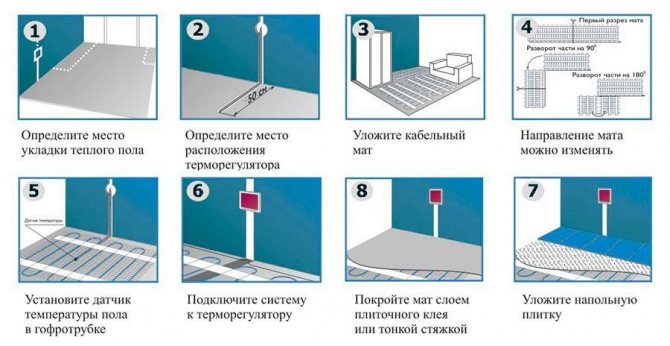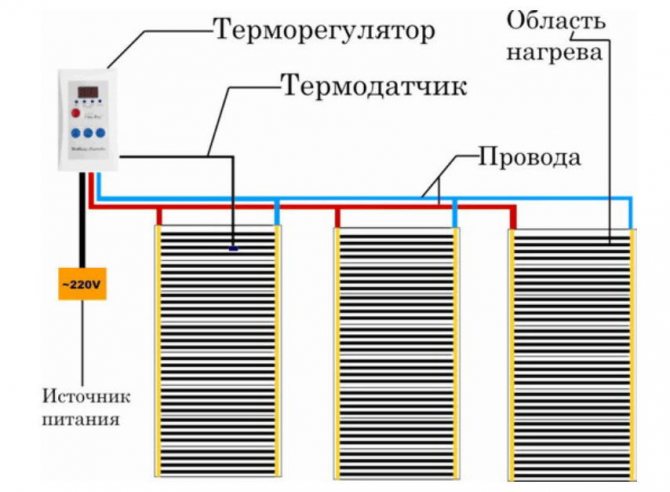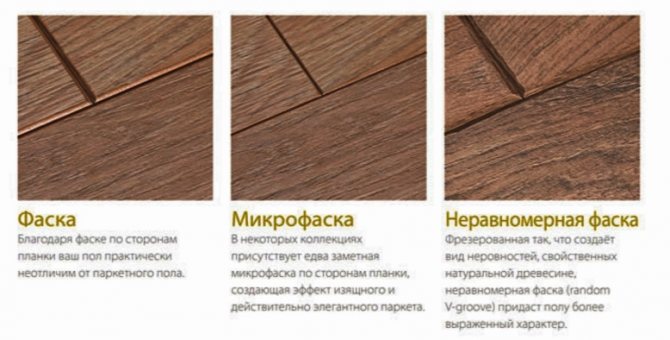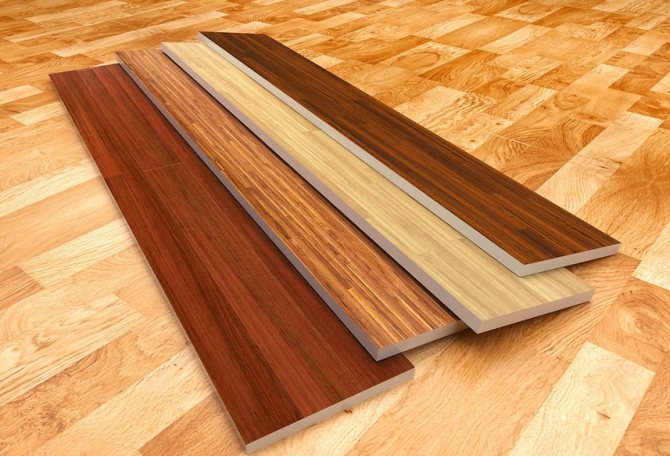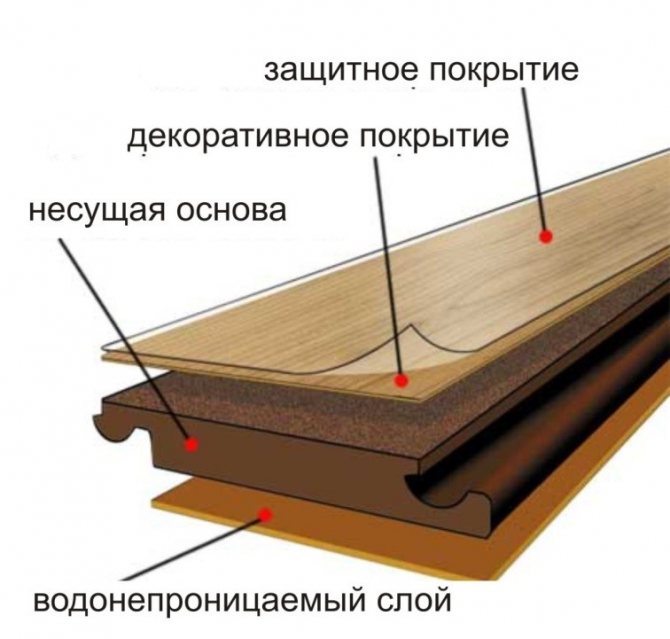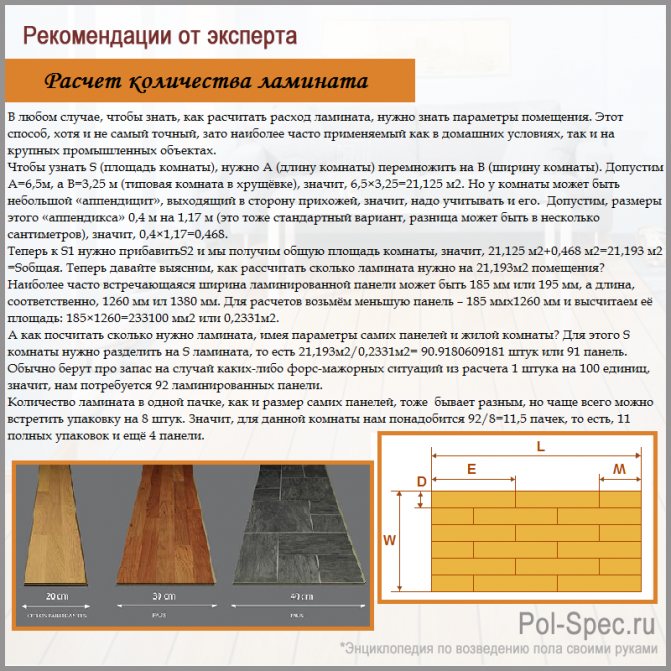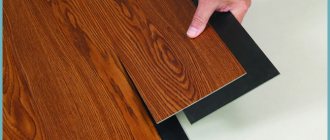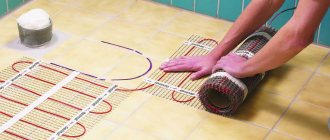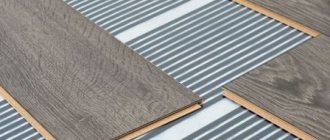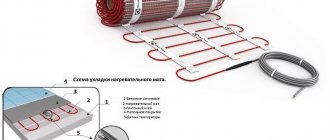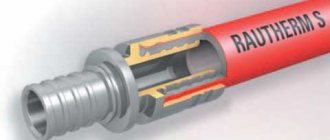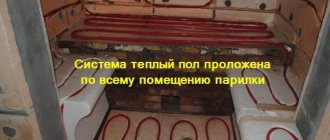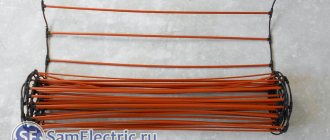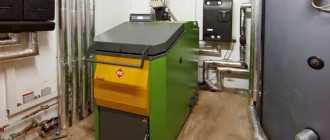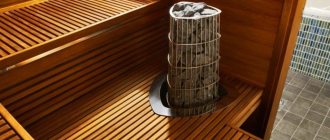Home »Equipment» Warm floor
The underfloor heating system is laid on a concrete or wooden base. For the water line, cable sections and mat, for carbon rods, a sub-floor made of concrete is preferable.
Heating elements show their effectiveness when covered with mortar. The screed is a good heat conductor, it cools down for a long time. It maintains a certain mode of the floor covering when the heating system is turned off. Heating elements can also be placed on a wooden base; use a dry styling method.
The disadvantage is that it costs a lot to maintain a normal room temperature. For laminate flooring, wood is preferred over concrete screed.
The best option for underfloor heating under a laminate is infrared heating with thermal foil. Any rough finish and floor cladding is suitable for it. How to install laminate flooring if the heating system is on a wooden subfloor?
Implementation options
Heating an apartment or house with "warm floors" has a number of advantages in comparison with the traditional version, with the use of heating radiators. So, it remains only to decide which warm floor under the laminate is best suited for this coating.
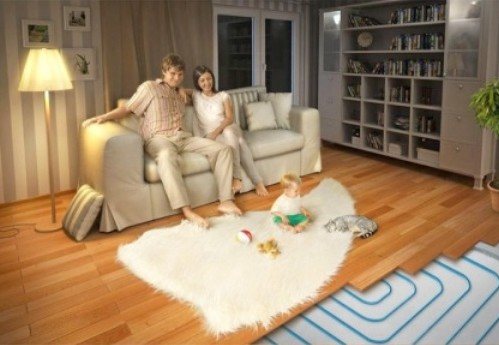
For the device of the "warm floor" system three main technologies are applied:
- Using water heating;
- Using electric cable;
- Using electrical panels with infrared radiation.
But are they all suitable for use with laminate flooring? And in general, is it possible to lay underfloor heating under the laminate? In order to answer these questions, it is necessary to study the features of the listed systems in somewhat more detail.
Water
Functions on the basis of hot water moving through pipes hidden in the floor... Consists of several layers:
- Waterproofing, with the obligatory laying of a damper tape around the perimeter of the room.
- Then comes a layer of thermal insulation, which can be foam, expanded polystyrene and other insulating materials.
- Pipes with a small section are laid on it, poured with a concrete screed.
- The last layer of the structure is the topcoat, in this case the laminate.
The main disadvantage of this type of system is the laboriousness of installation. In addition, an underfloor heating water floor should not be installed under the laminate due to the existing risk of pipe burst under the coating.
Such a "nuisance" may well occur in the event of a pressure surge in the system. As a result, a beautiful, practical floor will be ruined. therefore the water-type heating system is not suitable for use in conjunction with a laminate covering.
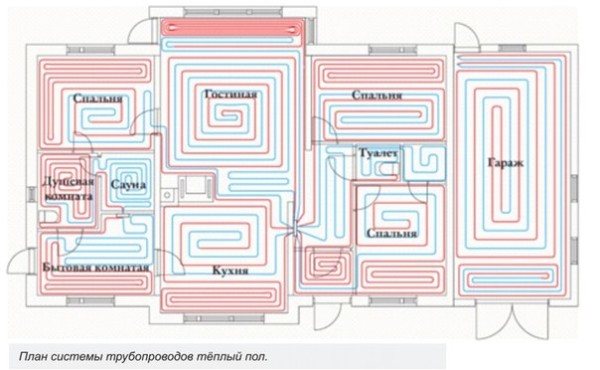

Electric cable based
When using this type of "warm floor" the room is heated using a two-wire electric cableconverting electrical energy into heat.
It is laid on a carefully leveled, cleaned surface covered with a layer of thermal insulation. Underfloor heating laminate is usually made of high quality and durable materials with high thermal conductivity.: extruded polystyrene foam, expanded polystyrene foam or cork.
From above, the cable is closed with a thin concrete screed made using a reinforcing mesh, on which the laminate is laid.
The main advantage of this type of system is simplicity and ease of manufacture.... Installation of a warm electric floor under a laminate can be done independently, without the involvement of specialists.
As for the shortcomings, the main one is the high operating costs associated with paying for consumed electricity. But such a system combines very well with laminate.
Infrared
This underfloor heating system for laminate is the most modern and technologically advanced... At the heart of its design, an infrared-type film is used, laid on a heat-reflecting material (penofol or penoizol) and covered with a polyethylene layer on top.
Infrared underfloor heating has a number of advantages compared to other heating options. These include:
- Durability and structural reliability;
- Convenience and ease of installation;
- Minimum terms of work execution;
- Saving space due to the absence of the need for filling the screed;
- Greater cost-effectiveness compared to cable-type floors.
But this system also has its obvious disadvantages. For example:
- High cost;
- Impossibility to use in rooms with high humidity;
- The presence of a perfectly flat, smooth base.
This type of underfloor heating works very well with laminate flooring.
Having decided to use water-based underfloor heating in conjunction with a laminate as a heating source, you need to pay attention to the following points:
- When connecting "warm floors" to a centralized heating system, it is better to use coverings of other types, since the laminate is very sensitive to waterlogging, which can occur when a pipe ruptures due to a water hammer. That is, it can only be installed on water floors connected to autonomous heating systems, for example, in private houses.
- To achieve the best effect the base on which the pipes will be laid must be carefully insulated... Pipes should be fastened to a reinforcement mesh or special profiles equipped with clamps. In addition, for this purpose, you can use mats designed for laying a water-heated floor, which can simultaneously perform the functions of a waterproofer, insulation and pipe fixing.
Thus, the energy from the coolant will not be wasted.
By installing warm floors in your home under the laminate with your own hands, you can use a different technology for the device of water-based systems, without using a screed.
This installation method can be used in rooms where a wooden board is used as a base..
In these cases, a flooring system is installed, which can be wooden or polystyrene. In another way, it is called "dry warm floor".
Vapor barrier and thermal decoupling
A vapor barrier material is installed on top of polystyrene or mineral wool. An ordinary film is never used in its capacity, since condensation forms, which makes the insulation moist. Good experts advise making a vapor barrier from special films.
Plywood and a heat-reflecting element are placed on top of the vapor barrier. Plywood is the base on which the slats are fixed. It also strengthens the base for the laminate and thereby prevents it from sagging under the weight of people living in the house.
A heat-reflecting underlay is very popular for electric underfloor heating. Also, it is not superfluous for water systems. It not only reflects heat upward, but also prevents the underlying materials from heating up. One of these materials are floor beams. This heat-reflecting substrate is foil or foamed foam.
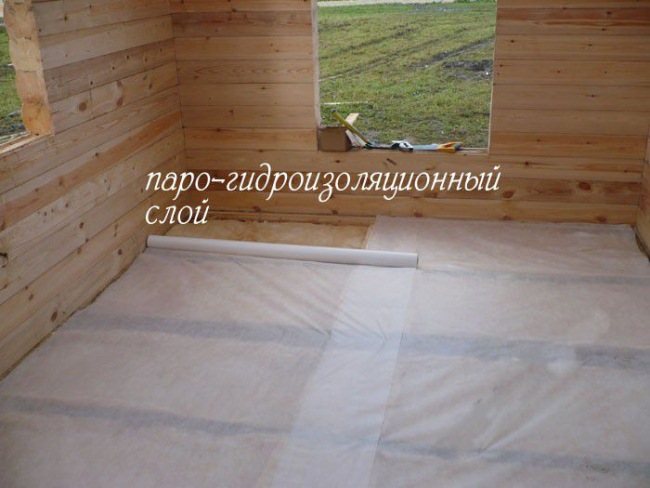

Vapor barrier and thermal decoupling
In the case of the installation of electrical heating elements, the reflective screen is subject to increased requirements. So, it should not pass an electric current. Therefore, it is made from a material that is not capable of conducting current, and is also laminated with a film, which serves as an additional insulation. The thickness of the reflective screen substrate does not exceed 5 millimeters. If this value is greater, then the material absorbs well, which is a bad phenomenon for coating.
Materials and equipment
Installing a warm floor under a laminate requires the use of a certain set of materials and equipment, which include:
- Waterproofing;
- Pipes with a diameter of 16-20 mm. They can be made of polyethylene, metal-plastic or copper;
- Damper tape;
- Plasticizer;
- Collector group;
- Insulation (expanded polystyrene);
- Thermoregulators;
- Pump-mixing block;
- Fasteners.
For an electric floor you will need:
- Two-core cable.
- Foil polystyrene.
- Heat-reflecting material (isolon or infraflex).
- Fasteners, temperature regulator.
Before laying the warm floor under the laminate, it is necessary to carefully level the base on which it will be located using flooring or cement-sand screed.
Structure
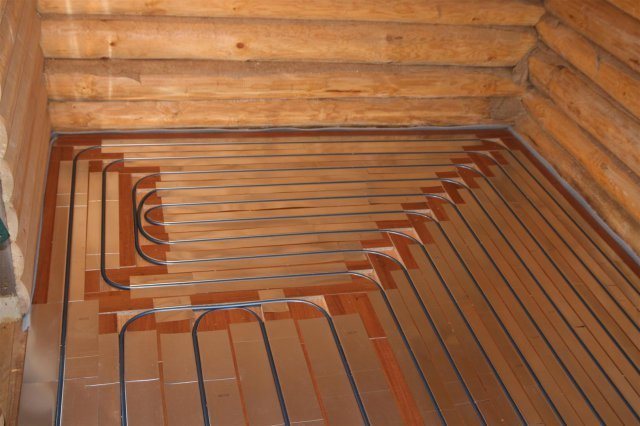

Water or electric floor construction
The construction of a water or electric heated floor under a coating such as a laminate is as follows:
- beams placed at a distance of 60 cm;
- rough covering, which is located between the beams;
- vapor barrier material;
- thermal insulation material;
- waterproofing:
- plywood nailed on top of the beams:
- heat shield;
- slats made of wood or plywood;
- metal heat distribution elements (located between the rails);
- pipes placed on metal heat distribution elements or electrical wires;
- laminate backing;
- laminate.
DIY installation
Before you put a warm floor under the laminate, you need to decide on the option of laying it... It can happen as follows:
- By lags. To do this, it is convenient to use special modules made of chipboard, which are factory equipped with grooves with special channels, thermal distribution plates made of metal and all the necessary fasteners. They only need to be assembled in accordance with the instructions. But such a kit is very expensive.
- On racks... To do this, use a planed board, moisture-resistant plywood or chipboard with a thickness of 21-28 mm. The distance between the slats is usually equal to their width, and the width corresponds to the distance between the pipes in the circuit.
Preparation of the base
When laying the "water underfloor heating" system on a wooden base, installation must be carried out after a set of preparatory works, which include:
- "Opening" the old coating and the base located under it... At the same time, old hydro- and heat-insulating materials are removed, and the base itself is cleaned of traces of dirt, mildew and mold.
- Visual assessment of the general condition of the foundation. It needs to be inspected for various damage. At this stage, sections of the beams that have become unusable should be dismantled, replacing them with new inserts. If strong distortions and blockages of the surface are found, it must be leveled using metal corners, special pads and other fixing elements.
- Treatment of a wooden base with antiseptic preparations... This will avoid further decay and destruction of this material.
The last stage in the preparation of the foundation is its cleaning from dust and debris... Detailed instructions for preparing a warm floor for a laminate can be found in the video presented on the Internet.
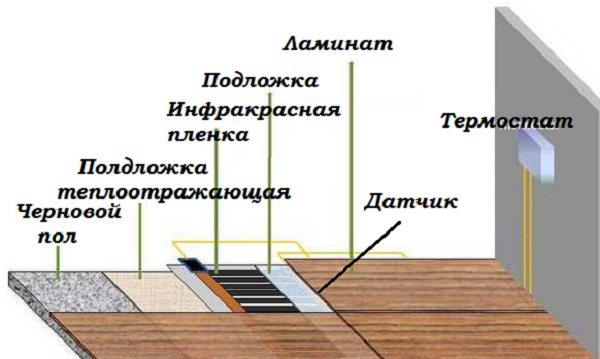

Frame fabrication
When laying a warm water floor on a supporting wooden structure with a spacing of beams up to 60 cm, work can be carried out directly on this base... For this, cranial bars are fixed at the bottom of the beams, acting as supports. Subfloor boards are stuffed on them.
It is possible to lay a subfloor without cranial bars.... In this case, the boards are fixed directly into the supporting beams from the basement or underground side. The space between the supporting lags is filled with a vapor barrier material, on which a layer of thermal insulation 15-20 cm thick from mineral wool, expanded polystyrene or foam is laid.
The distance between the primary floor and the thermal insulation layer must be at least 8-10 cm. For additional ventilation, it is advisable to leave a small unprotected area in the "draft base" near the wall.
When making a frame for floors with a beam pitch of more than 60 cm, the cranial bars should be fastened at a higher height, since the subfloor in this case will be attached to chipboard or plywood nailed to the support beams.
After the insulation, it is necessary to attach a vapor barrier layer. You can find out in more detail how the warm floor is laid under the laminate in the video.
Pipe laying
For the installation of water-based underfloor heating, pipes made of polypropylene and metal-plastic are used... Their layout can be done in two ways:
- in a spiral;
- snake.
The first method is more preferable, since in this case there is an alternation of "cold" and "warm" circuits.
At home, it is easier and more convenient to lay pipes "snake". They should be laid out in increments of no more than 30 cm. Near the walls, the step can be minimal: 10-15 cm. This will avoid heat loss at the junctions.
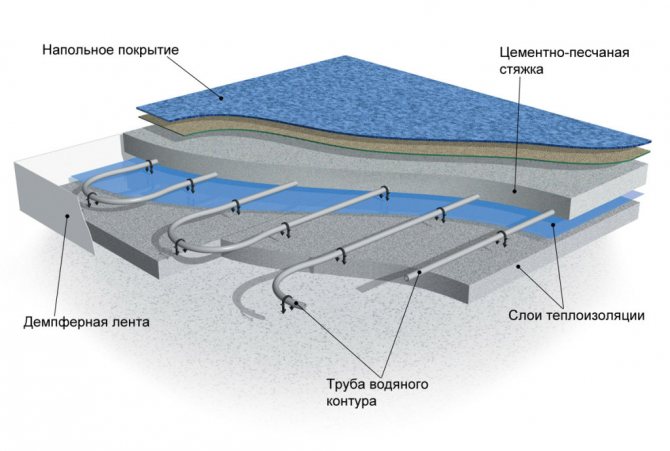

Connection
Connecting underfloor heating to the heating system can be carried out in various ways... The most common are:
- Mixing units;
- Collector system.
After that, the crimping procedure is performed, the main purpose of which is to identify leaks and malfunctions in the pipeline. This operation must be carried out before laying the floor covering!
For "safety net", a test run is best done in conjunction with specialists. Additional information on connecting underfloor heating under a laminate with your own hands can be found in the video.
Infrared floor heating pros and cons, find out all sides of this type of heating. Read what is the best electric underfloor heating, how to choose the right one and how to lay the covering.
Choose the right electric boiler for heating a private house, recommendations for choosing here.
Substrate
After the technical part of the structure has been tested under increased pressure, a substrate is laid on top of the pipes, the function of which can be performed by the following materials:
- Bung;
- Foamed polyethylene foam;
- Foil polystyrene;
- Extruded polypropylene.
The listed materials have different costs. For example, the most expensive is the foil-clad polystyrene backing. But she also has the highest thermal insulation characteristics.
Base and insulation
The basis of a warm water floor is made up of beams and wooden elements attached to them. There is a subfloor between the beams at the bottom.
The basis of a warm water floor
In many cases, it is nailed to the underside of the beams. If this overlap is interfloor, then from below on this subfloor the installation of finishing ceiling material is carried out. On top of this floor is a vapor barrier material. It is necessary to protect the insulation from moisture coming from below. For this purpose, a waterproofing film or diffusion membrane is used. It is best if such a substrate is spread with a solid sheet over the beams and spread between them so that it fits snugly against the subfloor.
Thermal insulation is installed on top of the waterproofing substrate. It can be expanded polystyrene or basalt wool mats. The width of the sheets of these materials should exceed the distance between the beams by 5 centimeters. Due to this, the insulation is tightly placed between the floor logs, which eliminates the chances of gaps through which air can move. The desired thickness of the insulation is 100 millimeters. Thinner material can also be used. This is noted in many videos about the installation of thermal insulation.
Laying laminate
After the installation of the underfloor heating under the laminate is completed, you can proceed to the most important stage of finishing work - laying the topcoat... This requires:
- Prepare the floor, preheating it for 48-72 hours. Then the heating is turned off. At the time of installation of the coating, the surface temperature should be about 15 degrees.
- Bought the laminate is also adapted to future operating conditions... To do this, it is unpacked and laid out in the room where it will fit, for about a day.
- For laying on a "warm floor" it is necessary use a coating with the appropriate marking: E1 or E0, which meets the most stringent environmental safety requirements, and the inscriptions: "Underflоorheating" or "Warm Wasser".
The installation method can be any, depending on the architectural features of the room and your own preferences.
Warm floors: general principles of the device
The heating elements located under the laminate generate heat, which is evenly distributed over the floor surface. You can find out which laminate for a warm water floor to choose by marking or from the manager of a specialized store. If the structure is installed correctly, then the heat is directed up to the surface of the laminate floor, and heat loss is minimal.
The underfloor heating structure for any type of heating element must consist of:
- a layer of insulation;
- to remove excess moisture, a membrane-type vapor barrier is installed;
- mounting elements or metal, plastic mesh for laying underfloor heating;
- heating elements - water heating pipes, electrical films, mats or cables;
- distribution layer;
- standard laminate backing according to the manufacturer's recommendations;
- laminate topcoat.
Cost of work and materials
Another important point that excites those who want to install a warm floor under the laminate: prices for materials, installation and work on its device.
They depend on the complexity and area of installation, as well as on the manufacturer of this floor covering. For example, the average prices for the products of the most famous and popular brands will be as follows:
| Firm | Model | Class | Warranty period | Dimensions, mm | Price per sq.m, rub. |
| TARKETT, Russia | Woodstock Premium | 33 AC5 | 25 | 1292Х194Х8 | 630 |
| CLASSEN, Germany | Futuro harmony ml | 32 AC4 | 15 | 1286x194x8 | 555 |
| KRONOTEX, Germany | Dynamic | 32 AC4 | 20 | 1380x193x8 | 500 |
Pay attention, when purchasing a laminate under a warm floor, before choosing one or another model, you need to make sure that it is suitable for water heating systems!
Service cost will be:
- Installation of hot water floors: from $ 7 per square meter.
- Floor laying electric type: $ 5 to $ 7.
- Infrared device underfloor heating: $ 3-5.
- Laying laminate: $ 2-4 per square meter.
Do-it-yourself water meter installation: tips and tricks, step-by-step instructions and tips from the masters in our article. Read how to make a solid fuel boiler for long burning with your own hands at https://klimatlab.com/otoplenie/tverdtoplivo/tverdotoplivnyj-kotel-dlitelnogo-goreniya-svoimi-rukami.html
Varieties of warm heating
There are only two types of underfloor heating - electric and water. There are various variations, but the essence of the system does not change from this: they use the first or second heat source.Both types are laid according to certain rules, observing the technical characteristics of the base material, screed, heating elements, top finishing coating, and so on. All these requirements must be met, since the durability and efficiency of heating depend on them.
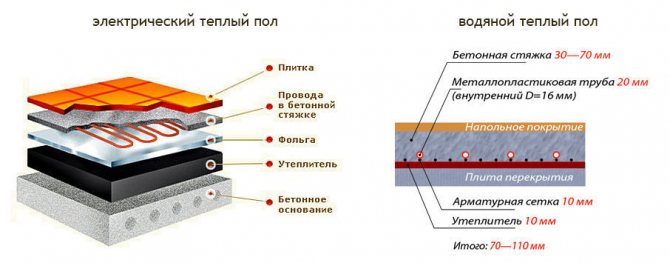

Electric and water underfloor heating
At the time of the appearance of the technology, it was recommended to lay heating elements exclusively on a concrete base under ceramic tiles. Due to the appearance of new materials, the heating can now be installed on a wooden base under the laminate.

